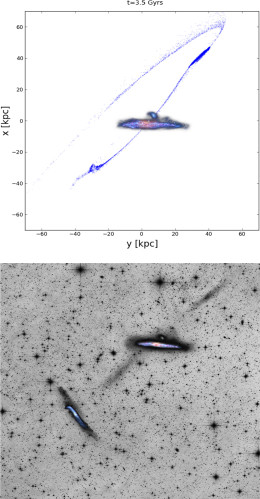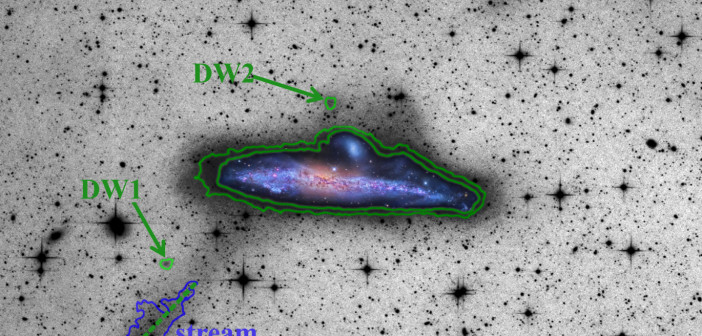The Λ-cold dark matter cosmological model predicts that galaxies are assembled through the disruption and absorption of small satellite dwarf galaxies by their larger hosts. A recent study argues that NGC 4631, otherwise known as the “Whale” galaxy, shows evidence of such a recent merger — in the form of an enormous stellar stream extending from it.
Stream Signatures
According to the Λ-CDM model, stellar tidal streams should be a ubiquitous feature among galaxies. When satellite dwarf galaxies are torn apart, they spread out into such streams before ultimately feeding the host galaxy. Unfortunately, these streams are very faint, so we’re only recently starting to detect these features.
Stellar tidal streams have been discovered around the Milky Way and Andromeda, providing evidence of these galaxies’ growth via recent (within the last 8 Gyr) mergers. But discovering stellar streams around other Milky Way-like galaxies would help us to determine if the model of hierarchical galaxy assembly applies generally.
To this end, the Stellar Tidal Stream Survey, led by PI David Martínez-Delgado (Center for Astronomy of Heidelberg University), is carrying out the first systematic survey of stellar tidal streams. In a recent study, Martínez-Delgado and collaborators present their detection of a giant (85 kpc long!) stellar tidal stream extending into the halo of NGC 4631, the Whale galaxy.
Modeling a Satellite

The top image is a snapshot from an N-body simulation of a single dwarf satellite, 3.5 Gyr after it started interacting with the Whale galaxy. The satellite has been torn apart and spread into a stream that reproduces observations, which are shown in the lower image (scale is not the same). [Martínez-Delgado et al. 2015]
To support their observations, the authors modeled the system using an N-body simulation. They were able to reproduce the appearance of the stream by sending a single, massive dwarf satellite onto a moderately eccentric orbit around the Whale galaxy. The team showed that, over the span of about 3.5 Gyr, the satellite became disrupted and spread into a structure very similar to the stellar tidal stream we now observe. In this simulation, the last remains of the dwarf satellite are contained within the northwest arm of the stream.
The authors point out that the Whale galaxy has additional gaseous tidal features that likely originated from a more recent, gas-rich accretion event. There are also two bright regions that may be more dwarf satellites around the galaxy (labeled DW1 and DW2 in the header image). If the authors’ interpretation of the observed stellar stream is correct, then the Whale galaxy shows evidence for multiple recent mergers. This would support the idea that hierarchical formation models apply to other galaxies similar to the Milky Way.
Citation
David Martínez-Delgado et al 2015 AJ 150 116. doi:10.1088/0004-6256/150/4/116


1 Comment
Pingback: The Whale caught in the act of dining